|
|
|
the Dead Sea
Saturday, October 1 2005
setting: 80 Hayarkon Street (near the US Embassy), coastal Tel Aviv, Isræl
Dina, whose marriage we'd come to Isræl to attend, works mostly for the Associated Press, but recently she's had a few assignments with the New York Times and even had some of her reporting on the Gaza withdrawal featured on page one. As she'd been when we saw her in South Africa, she's in close contact with others working in the press. One of her press friends is Ruth, a Pulitzer-Prize-winning photographer for the Times. At the wedding yesterday, Gretchen had with Ruth for us to ride with her westward across Isræl
to the Dead Sea.
This morning, after a series of extended goodbyes exchanged with Gretchen's family, Ruth picked us up at the hotel and we were off to Jerusalem, which is on the way to the Dead Sea. Though Ruth is American, she must have a lot of experience in Isræl because she drives like a goddamn Isræli, a nation where following distances are best measured in millimeters. (Interestingly, though, people seem to obey speed limits better in Isræl than in North America, perhaps because of the frightening expense of gasoline - more on that later.)
While Tel Aviv hugs the featurelessly straight north-south coast and its suburbs sprawl across a broad, flat coastal plain, Jerusalem is to the southeast and sits atop a steep rocky ridge rising 2,550 feet above sea level. I'm unfamiliar with cities of any consequence being perched atop mountains (the only other one I can think of offhand is Jerome, Arizona), and this was only my first surprise about the fabled city.
Jerusalem is and has been a particularly contested piece of real estate for thousands of years, with perpetually overlapping claims of both a political and religious nature. Upon the creation of the State of Isræl in 1948, the city was immediately surrounded and besieged by irregular Arab forces and a battle to open a supply line was fought along the roadway we were now taking up the mountain, the main route from Tel Aviv to Jerusalem. Isræli seeking to resupply the city were shelled by Arab positions atop the scrubby hills. Ruth pointed out the broken tanks and armored trucks that still dot the route, now painted in brick-red anti-rust paint and left as a reminder of the sacrifices necessary to forge the nation. At the top of the hill is the Jerusalem city limit with a 1970s-style welcoming sign seemingly made of astroturf. Beyond that anachronism, though, Jerusalem had a mostly timeless appearance, with all of its buildings faced with the same cream-colored Jerusalem limestone, a requirement of local building ordinances. Even a seemingly-misplaced Dutch-style windmill, added to the Jerusalem skyline when it was smaller and in desperate need of restoration, is made of it.
Our first stop was in the neighborhood of Baka, where we picked up Ruth's friend, the office manager for the New York Times' Jerusalem bureau, who would be joining us on our trip to the Dead Sea.
On the way out of town, we stopped in Arab East Jerusalem so Ruth could buy a luggage bag (it being Shabbat, few Jewish merchants were open). There was a military checkpoint at the main road passing the walled Old City into East Jersualem, and it was heavily-manned by bored-looking Isræli troops and police, all of them carrying large machine guns. Unlike the West Jerusalem, East Jerusalem was bustling with activity and commerce. Its streets were decidedly more medieval than those I'd seen in the more modern West Jerusalem, cramped, cluttered, winding, and seemingly incapable of sustaining the traffic volume passing through them. As with everywhere else in Jerusalem, the drivers seemed to be profligate risk takers and highly impatient. Still, it was possible somehow to just turn on the emergency lights and stop in the street to transact five minutes worth of business and receive a little harmless flirtation from a favorite money changer.
On the way eastward out of town across the West Bank, Ruth pointed out the large Jewish settlement of Maaleh Adumim crowning one of the hills. It's completely illegal but is tolerated by Isræl despite the rage it stirs among Palestinians. With a population of 32,000 people, it's a fact on the ground that won't be anywhere near as easy to erase as other illegal Isræli settlements, such as those recently removed from Gaza.
The land turns rapidly arid as one heads east from Jerusalem and passes into the rain shadow of the Jerusalem plateau. As a site for Isræli settlements, it has nothing to recommend it except proximity to jobs in Jerusalem. In the absence of such settlements, the region is a mostly vacant stony desert, with occasional semi-permanent Bedouin encampments (made semi-permanent by regular water and hay deliveries provided by the Isræli government).
As one descends from the heights of Jerusalem towards the Dead Sea, the elevation eventually drops to sea level and then continues downward for another 1300 feet to the lowest spot on the Earth's surface. Periodically along the route there are tile "watermarks" on the landscape giving the elevation, and the one at sea level is the most popular, because here you can have your picture taken with a Bedouin and his camel, both in colorful tribal outfits. According to Ruth, the same Bedouin (and presumably the same camel) have staffed the sea level picture spot for many years. There are other photocamels at other elevational markers and in places where one might stop to get food or gasoline, but none are as famous as the one at sea level.
As for us, we stopped somewhere for falafel and drinks and I had my first experience with ordering genuine Middle Eastern falafel. In Isræl, falafel is ordered like a sandwich at Subway, with you picking the things that are added in real time. Characteristic of Isræli falafel is that it can (and really should) contain pickles and french fries, among many other things. Also, don't be a wuss and be sure to ask for lots of harif, which is both Arabic and Hebrew for "hot."
The Dead Sea stretches out to the south of where the road comes in from Jerusalem. Beyond it are the barren mountains of Jordan, while its rocky western cliffs have often served as refugia for ascetics, monks, and ¨berfundamentalists of all the region's religions. The northern part of the Dead Sea's western shores lie within the contested West Bank, but we were headed further south, to a beach safely within Isræl's 1948 boundaries.
The beach was a tidy, orderly place that cost a certain number of sheqels to enter. We set up our stuff under a canopy of dead palm fronds, one of many such canopies along the shore. Then we waded out into the water.
I'm using the term "water" loosely. The fluid in the Dead Sea is only about 85% water and the rest consists of ions of various salts, with Magnesium Choride predominating. Since this is a very different chemistry from ocean water, Dead Sea water seems alien. It feels oily to the touch and if you're crazy like I am and venture to taste it, it's unpleasantly bitter, but not in a lingering way. Since the water contains so many minerals at or near saturation, it is much denser than either fresh water or sea water. This makes drowning in the Dead Sea an impossibility without the deliberate use of weights. There was, nevertheless, a lifeguard stationed at the beach to save people from a danger unique to this sort of was water. Since it is so concentrated with salts, Dead Sea water must be kept away from the eyes. The moment it gets into your eyes in any quantity it burns so badly that it becomes impossible to act in a rational manner and you'll need to be rescued, though there's still no chance that you'll drown. The lifeguard doesn't swim out to rescue people suffering in this way (that would be impossibly dangerous). Instead, he rows out in a boat, perhaps equipped with a dose of fresh water to rinse out the victim's eyes on the spot.
As I was wading in, I managed to get one little drop in my eye and I needed Gretchen to fetch me some fresh water, though my tears probably would have taken care of it.
As someone who has always been denser than normal, I was delighted by the ease of swimming (or, more accurately, floating) in the Dead Sea. You can choose to recline on your back in the bathwater-warm überbrine (though this does eventually strain neck muscles trying to keep the head out of the eye-searing fluid). Or you can lie on your belly and gently swim, trying not to splash too much.
The minerals are in such heavy concentration in the Dead Sea that they go back and forth between solid and dissolved forms. The floor of the Dead Sea is encrusted with layers of various salts, some comprised of large crystals. This layer is seldom more than a few inches thick and if you smash through it you'll find layers of clay or marl, much of it dark grey to black in color (presumably from organic material washed by flooding from surrounding highlands). Visitors to the Dead Sea like to slather themselves in this goop because it supposedly does good things for the skin. I didn't notice anything spectacular happening to my skin but it was interesting to note that I could spend a good part of an hour in the water and the skin of my fingertips didn't shrivel even slightly, as it would, say, in a bathtub.
Eventually you are forced to leave the Dead Sea because it begins to eat at tiny injuries you might not know you have. Women report that at a certain point it makes unwelcome, unpleasant advances on their various private parts.
But the Dead Sea experience doesn't just take place in the water. The shoreline beach experience is unusually relaxing as well, perhaps because here there is more oxygen per inhaled breath than anywhere else on Earth. There are also salt dusts and gasses in the air, particularly those containing Bromine, and Ruth told us these are known to have a sedative effect. The increased amount of atmosphere (some of it dusty and mineral rich) between you and the sun makes sunburn less of an issue here than it is at other beaches, even on a perfectly cloudless day in the desert.
Dead Sea beaches in Isræl disproportionately attract its Russian population, since (as Ruth explained) Russians have a particularly strong cultural attraction to healing waters. Indeed, a noticeable fraction of the conversation overheard on the beach was in Russian and many of the people had wide rectangular Russian faces.
After we were done with the Dead Sea itself, we tried soaking in a semi-indoor sulfur pool but were forced to flee when threatened by a long strand of floating human hair.
On the way back to Jerusalem we stopped at a kibbutz which operates a world-famous spa products company using Dead Sea salts as raw materials. At the kibbutz store such products can be had for a deep discount and that's what had the ladies excited while I went off to do something slightly less girlie, drink a cappuccino.
On the way back to Jerusalem we passed through two different military checkpoint on the road, but were always waved through since all of us, even the three Jewish women with me, looked more European than Semitic. Racial profiling is just a fact of life at these checkpoints, where carrying a sufficient amount of European rapist genes is better than holding an American passport.
Ruth dropped us off at the King David, a posh old British Mandate-era hotel in one of the higher parts of the city outside of (and not far from) the Old City. (The King David was bombed by the Jewish underground in 1946 and 91 people died.) Across the street was the YMCA with its 152 foot tower, and right next to that was the Eldon Hotel, where we decided to spend the night.
Eldon is a nation-wide car rental franchise that also runs a string of hotels and discounts for rooms can be had when rooms are rented. It's all very complex and was further complicated by a question Gretchen had for the receptionist about how possible it would be to find transportation to Lotan (in southern Isræl) during Rosh
Hashana, which would begin on October 3rd. The receptionist, an extremely (and thus, in a nation of fryer-defiers, unexpectedly) helpful woman, didn't think Rosh Hashana transportation would be possible except via an extremely expensive ride in a taxi cab. But then she priced out car rentals and this seemed like the most cost-effective option. It started looking like that we'd be driving a car in crazy Isræli traffic after all. The kicker, however, was the cost of the room: 130 sheqels a night, or a little over $30!
After resting for awhile in our room, we set out into the streets of Jerusalem. I brought my iBook along in case we found a WiFi hotspot (I'd yet to encounter any in Isræl at all, not even across the street from the American embassy in Tel Aviv).
After passing through Independence Park on the way to Yafo Street, we encountered a most peculiar sight. A Hasidic man was holding his youngish daughter by the legs and arms and shaking her gently over a some weeds along the sidewalk. The girl's pants were around her knees and it seemed like she might have just completed urinating. She was a little old to be needing help with this biological function, but it was all done in a very matter-of-fact fashion, as easy as not paying taxes, not serving in the military, and throwing up a raised ranch in the West Bank.
Our walk eventually took us to Ben Yehuda Street, which is so much like Charlottesville's Downtown Mall that I expected to find ten overlapping WiFi access points at the first street corner. Instead I found two, one of which belonged to a McDonalds. They were both encrypted. The lowest entrance to Ben Yehuda Street at Yafo Street was heavily-guarded by machine-gun wielding police, testament to the street's historic attractiveness to suicide bombers.
At the top of Ben Yehuda Street I did finally manage to find an open WiFi hotspot, probably in the tall office building across King George Street. I set up the iBook on top of a newspaper vending machine and Gretchen and I both took turns checking our email, amusing passersby.
By now the sun had set and the streets were once more full of crazy drivers now that no one was bound by Shabbat restrictions on fire starting. We'd been looking in vain for an open restaurant, but even with the end of Shabbat we were still out of luck. It takes a commercial kitchen awhile to get going once it's been shut down and most restaurants seemed unlikely to reopen until at least 8pm. So in the meantime we got by on a uniquely Isræli snack called "Beasley." It's a dehydrated pasta-like snack in various shapes and flavors. Gretchen's favorite is "grill" (pronounced "greel") and looks like rotini. It seemed likely I was never going to grow weary of that flavor.
After we seen the options and given up on downtown West Jerusalem, we began the trek back to our hotel, perhaps with the goal of heading to the Jerusalem neighborhood known as the German Colony. And then, about a block away, we saw a group of six or eight guys beating the hell out of somebody. As we drew closer they fled, leaving their victim face down and unconscious in a pool of blood. We stood there until green-uniformed Isræli police showed up. They raised the victim's feet and fanned his face until he started to come to. One of the first things he did was spit out a tooth. Suddenly he leapt to his feet and began swinging his fists, his brain resuming exactly with where it had left off. The police and various civilians managed to quickly calm him down and assure him that the threat had passed.
At first Gretchen had thought his attackers had been religious Jews, but apparently she'd been fixating on a bystander. She went into the shops and asked what had just happened and they all insisted it had been Arab-on-Arab violence. "But why?" Gretchen wanted to know. "Stahm," one said in Hebrew. That's a semi-untranslateable term that means "That's just the way it is."
We headed out from our hotel for a second time, this time towards the south. We soon found ourselves walking on a section of sidewalk along a stone wall that had been rendered only about a foot wide by all the cars parked on it (sidewalk parking is common in Isræl). I heard someone muttering behind me and I assumed it was just another impatient Isræli talking on his cellphone. But as he started brushing against me, Gretchen raised an alarm, so I turned around and saw that this guy was talking to me and didn't have a cellphone at all. He was trying to get me to give him some money. "Leave me alone!" I commanded in American English, and he immediately vanished. My initial feeling was pity for the guy. It sucks to be down on your luck, and it's even worse to be told off by an ugly American in your homeland. "Do you have your wallet?" Gretchen asked, wondering if the guy had pulled a sly pickpocket move. He hadn't.
We ended up eating at Café Masarik, a dairy-only restaurant, in the hip German Colony neighborhood. Sitting by a window, we could see all the vibrant, sexy young adult energy flowing by on the sidewalks. Most jarring, though, was the occasional sight of young men in casual clothes chatting with their friends and looking perfectly normal aside for the enormous machine guns strapped to their backs. You never know when you're going to need to start shooting in the Holy Land.
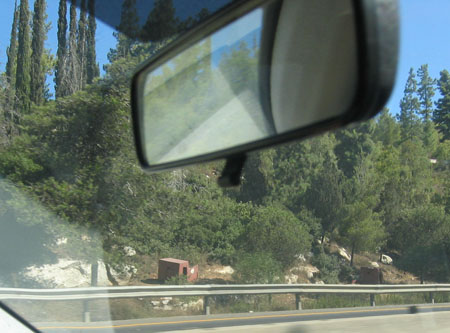
An armored truck (painted red) from the 1948 War for Independence along the road to Jerusalem.
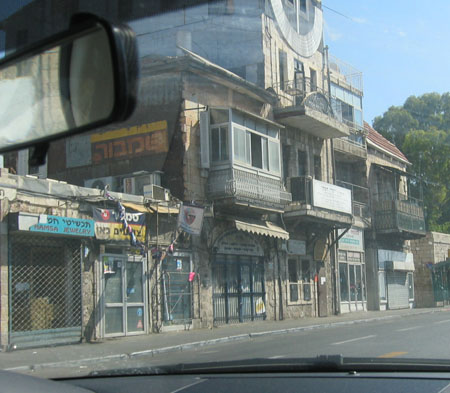
The empty streets of West Jerusalem during Shabbat.
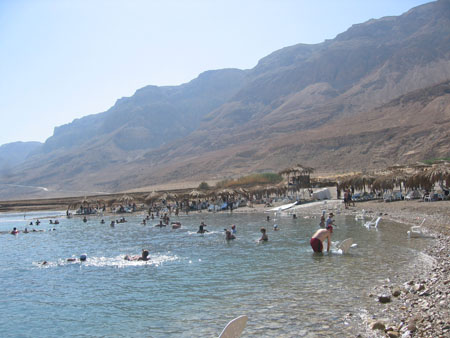
Cliffs above the Dead Sea.
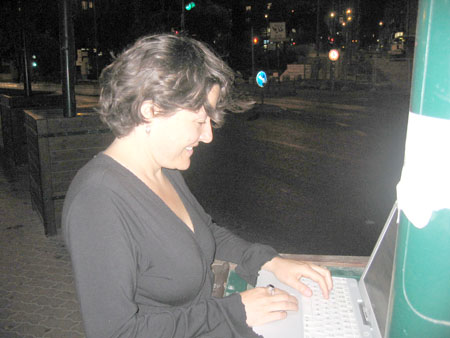
Gretchen checks her email at the top of Ben Yehuda Street.
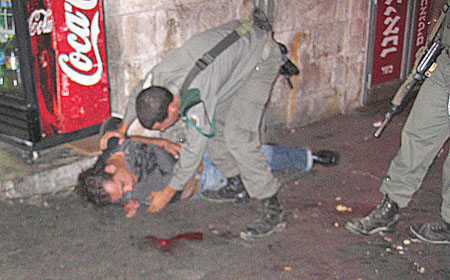
An Arab victim of allegedly Arab violence gets assistance from Isræli troops on Yafo Street in West Jerusalem.
For linking purposes this article's URL is:
http://asecular.com/blog.php?051001 feedback
previous | next |




